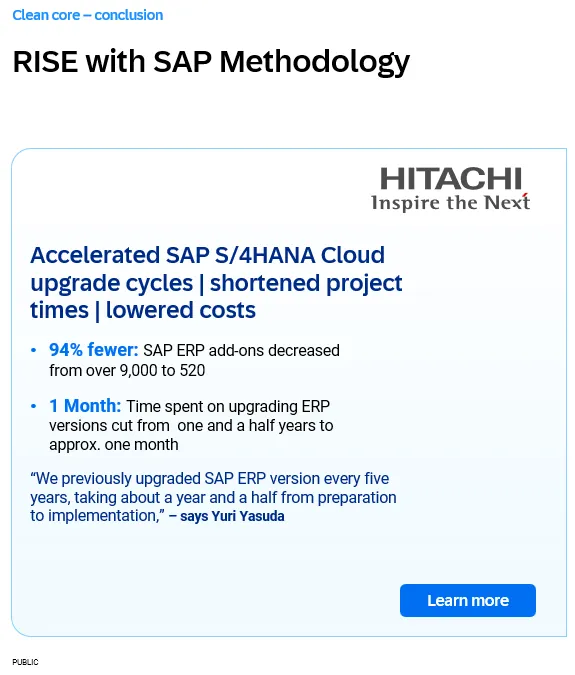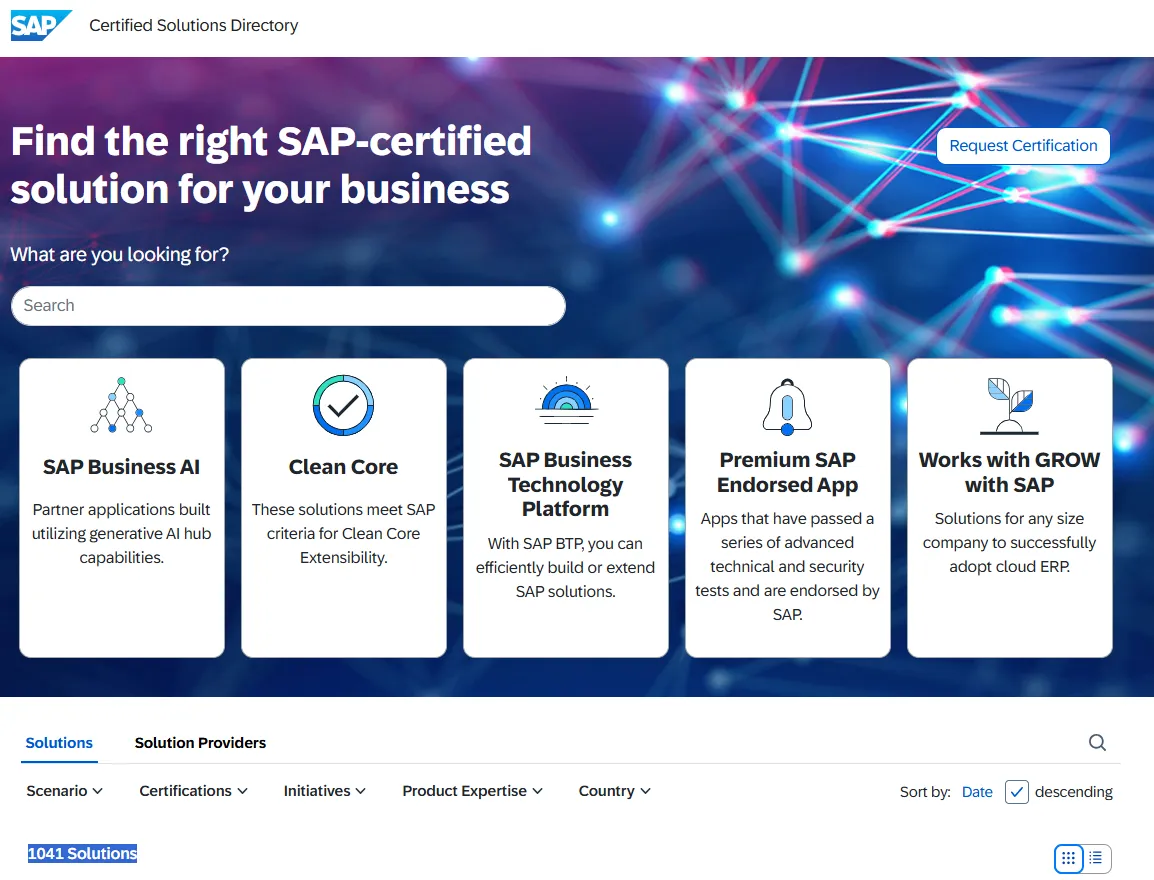I came across a presentation from SAP about clean core 🔗. It’s a L1 type presentation. This means it is a presentation focused on the why. The target group of such presentations is the manager that must be convinced to invest and not the person later charged with the task of doing so. These kinds of presentations show the importance of the inevitable challenge that must be solved and are full of motivational scenarios showing that it is possible to reach the promised land. One part of the presentation got my attention is where customers are shown that already solved the problems with flying colors.

The statement given here is that through clean core, Hitachi managed to reduce the number of their used SAP ERP add-ons by 94%. Down from 9,000 to 520. 9,000 add-ons. Let that number sink in. 9,000.
What is an add-on? Google returns the SAP Help page for the SAP Add-On Installation Tool and Support Package Manager 🔗. The tool (SAINT) is used to install add-ons. From this, basically everything you install via SAINT is an add-on. The documentation for the SAP Add-On Assembly Kit 🔗 details the content of an add-on:
- series of transport requests
- objects, customizing, modified objects.
Add-ons are registered “as an additional software component in the system”. Therefore, everything installed via SAINT and that is listed as an additional software component is an add-on. And what is a Software component 🔗? It “bundles a set of packages that can only be delivered to customers together”. As an example, Software Components are SAP_ABA, SAP_HR, SAP_APPL. HOME and LOCAL are also Software Components. Objects in HOME are assigned to a transport layer and normally not installed via an add-on.
An add-on is therefore not the usual Z-coding. It is installed via SAINT, added to the Software Component list. You can get a list of certified add-ons from SAP. There is a SAP site that lists the SAP-certified add-ons / solutions: Certified Solutions Directory 🔗. In August 2025 it lists ~1,041 solutions.

Not every add-on is available for all SAP products. Filtering [1] for add-ons for S/4HANA 2023 private edition gives: ~262 solutions.
With this in mind: 9,000 add-ons? What kind of SAP landscape is this? How do you even install 9,000 add-ons? How do you evaluate all those add-ons? Or vendors? Patches?
How did Hitachi get to 9,000 add-ons? How did they even manage to install 9,000 add-ons? 9,000 in one productive SAP system? Impossible. Is this the cumulated number across all SAP systems? How many add-ons does the average SAP system have? 3? 5? 10? Even with 15 add-ons, with 5 systems for maintenance and project, this would mean 60 landscapes. While this is not unrealistic, the assumptions to get there are. Rather think about 3, maybe 5 addons, a 5 systems landscape for maintenance and 3 for projects and the number of landscapes is already 225. Even when considering several countries with their own SAP systems: if you have running, we are not talking about a clean core problem, this is a general governance problem. Or complete lack of governance.
What else can be in the 9,000? Maybe Z-reports and transactions are shipped as add-ons? Clustering several Z-transactions together in one add-on would mean, what? At least 18,000 Z-transactions? What if 5 z-transactions or reports form one add-on? That number of custom transactions and reports is just too high. This is also not realistic. Again: such a high number of custom transactions/reports would still mean: governance problem. Or rather: why use SAP at all?
It cannot be 9,000 add-ons, nor 9,000 custom transactions. If someone is shipping each Z-Object as an add-on: not a clean core problem, this is governance. Or lack of. Hard to imagine that Hitachi would even allow such a situation in their SAP landscape.
But, maybe it is related to quality? Just not by Hitachi, but by SAP? Maybe the intention was to only have some dramatic number on a slide? Marketing focused (again) more on a number instead of content? Searching for “9000 hitachi sap” returns a search result which might be the missing piece to solve the puzzle.

A customer story about Hitachi 🔗. The number in question - 9,000 - can be found in the text: “Over time, Hitachi High-Tech had accumulated more than 9,000 customizations”. 9,000 customizations. Customizations, not add-ons. With this, the initial intention might have been to refer to RICEFW adjustments, to enhancements, custom coding. In this context, 9,000 makes sense.
So, either the author of the slide does not know what an add-on is, or opted for add-on as it is shorter than customizations, or because it sounds more important, is better to transmit the message of reducing complexity, or … doesn’t matter why. But can we focus just a little bit more on facts? 9,000 add-on is not the same as 9,000 customizations. And, honestly, 9,000 customizations are not the same as 9,000 enhancements or RICEFW.
This brings me to the title of this post: It’s over 9,000! In the original manga and anime series, the phrase is: over 8,000. Due to an error, or alteration, it was changed to 9,000. And now everyone is using it as a meme. The next time someone asks me how many add-ons we have, I just might answer: over 9,000!
[1] who did the filtering for in the certified solutions directory? What is the mandatory SAP Interface part in the scenario? Am I supposed to understand the right checkbox values? Why are they WRITTEN IN UPPERCASE?

Readability could be better.

